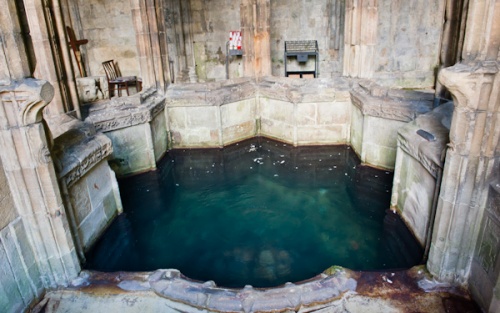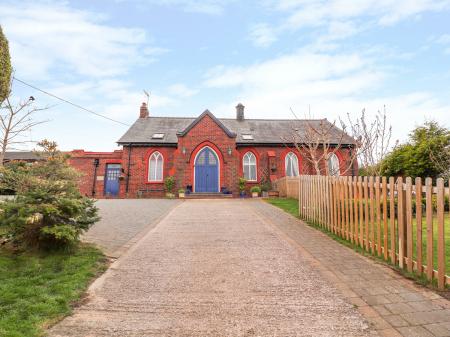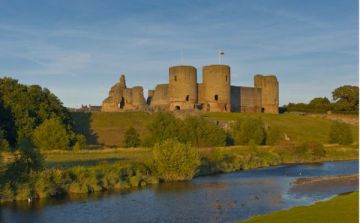

St Winefride
Winifred (the Anglicised version of the name Winefride), was a 7th-century Welsh woman, the daughter of a local chief and niece of St Bueno. Her family connections mean she is sometimes called a princess.
Winefride was pursued by a suitor named Caradoc, but when she told him she had decided to become a nun rather than give in to his advances, Caradoc flew into a rage. He cut off Winefride's head with his sword.
Versions of the story differ, but one popular version is that her head rolled down the hill, and where it came to rest a spring gushed forth from the ground. This spring and the well that later developed around it, have been thought to have healing powers ever since.
Winefride's uncle, Bueno, was passing, and miraculously managed to reattach the head to its body. He then called down the wrath of Heaven on Caradoc, who was struck dead on the spot, and the ground opened up to swallow his body whole.
Bueno then sat upon a stone and vowed that if anyone should stand or sit on that spot and three times ask God for help in Winefride's name, that help would be granted. The stone upon which he made this vow is called Bueno's Stone, and lies in the outer pool of the holy well.

beside the pool
As for Winefride, she carried out her vow and became a nun at Gwytherin (Denbighshire) and rose to be abbess. She died around 660 AD and was buried at her abbey.
In 1138 her bones were carried with great ceremony to Shrewsbury Abbey, where they became an extremely popular destination for pilgrims throughout the medieval period. The story of the relics being taken to Shrewsbury forms the basis of Ellis Peter's novel, 'A Morbid Taste for Bones', the first in her series of Brother Cadfael mysteries.
From the time of her death Winefride/Winifred was venerated, and the holy well became a place of pilgrimage. It is no exaggeration to say that St Winefride's Well has been a destination for pilgrims for over 1300 years, a span unmatched by any other British site. This long history as a place of pilgrimage has led Holywell to become known as the Lourdes of Wales.
The Shrine and Well
The well is contained within a beautiful early 16th-century building in Perpendicular Gothic style. This beautiful structure has a bathing pool within a star-shaped inner chamber, joined to a more modern rectangular bathing pool for pilgrims.
In the inner pool is St Bueno's Stone, taken from the nearby streambed. Look up at the vaulted canopy over the pool; it was erected by Margaret Beaufort, mother of Henry VII, and carries elaborate carvings of Tudor family symbols. Carvings depicting St Winifred are everywhere; one large carving is set on the ceiling, showing the saint with a staff and a crown upon her head.
The earliest written records of pilgrimages date to the 12th century, when pilgrims claimed healing from illness after bathing in the waters of the well. Among the treasures on display in the museum are wooden crutches thrown aside by pilgrims after healing.
The Chapel
Most visitors focus on the holy well and shrine, and that's understandable, but they miss a real historical treat; above the well rises a late 15th-century chapel, nominally in the care of CADW, but the key is kept at the holy well reception desk in the museum.
The chapel is really the 'above ground' part of the holy well structure; while the crypt provides a vaulted chamber over the well pool itself, the upper floors provide a chapel with a nave, north aisle, and apse. It is well worth exploring the chapel, especially for the exceptional corbel head carvings in the aisle. Look for the carved wooden head of a man sticking his tongue out.




Royal Pilgrimages
At least 6 royal visitors have come to Holywell over the centuries. The earliest recorded visit was by Richard I (King Richard the Lionheart) in 1189. Perhaps the most famous visit was by Henry V in 1416. Henry came to give thanks for his victory at Agincourt the previous year. He famously went on foot from Shrewsbury Abbey to Holywell as an act of reverence.
In 1461 Edward IV of England came on pilgrimage. According to an account by the Welsh poet Tudor Aled, the king took earth from beside the well and placed it upon his crown.
In 1686 James II and Queen Mary Beatrice visited the well to pray for an heir. An account written 110 years later says that the priests at the well gave the king the shift (a slip or chemise) worn by Mary, Queen of Scots to her execution. Mary, of course, was the king's great-grandmother.
In 1828 King Leopold of Belgium brought his young niece Victoria, the future queen of England, to Holywell. And finally, the most recent royal visit came in 2005, when HRH The Duchess of Gloucester came to the well and visited the museum.
The Museum
Visitors access the holy well through the museum, which has been created from a Victorian house built for the site custodian. I'm not usually one for museums, being more interested in the actual historic site; I came to Holywell to see the shrine and the chapel, but I was completely hooked on the site museum before I even got to the holy well.
The operators have done an extremely good job of telling the story of Winefride and her life, and how the holy well developed over time. It is an engrossing tale, and the museum really does add to the experience of visiting this wonderful historic site.









